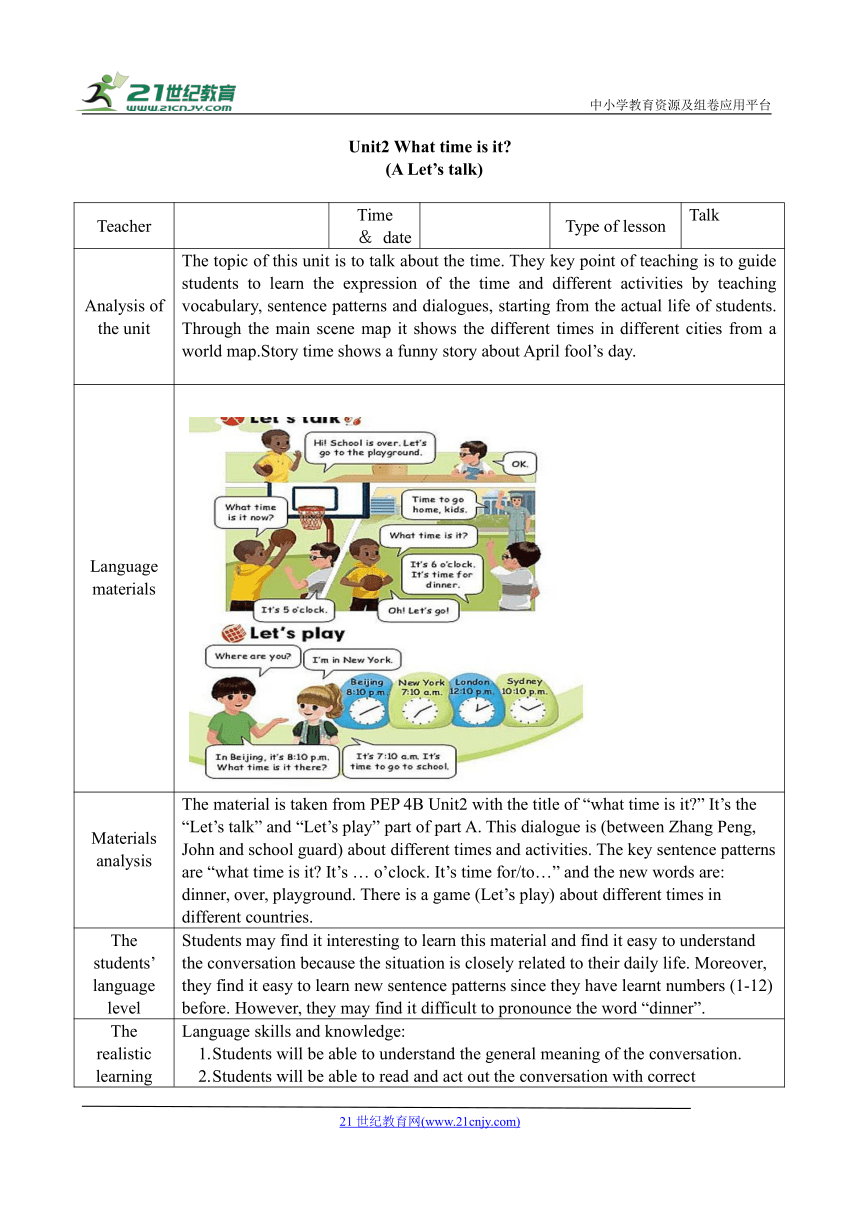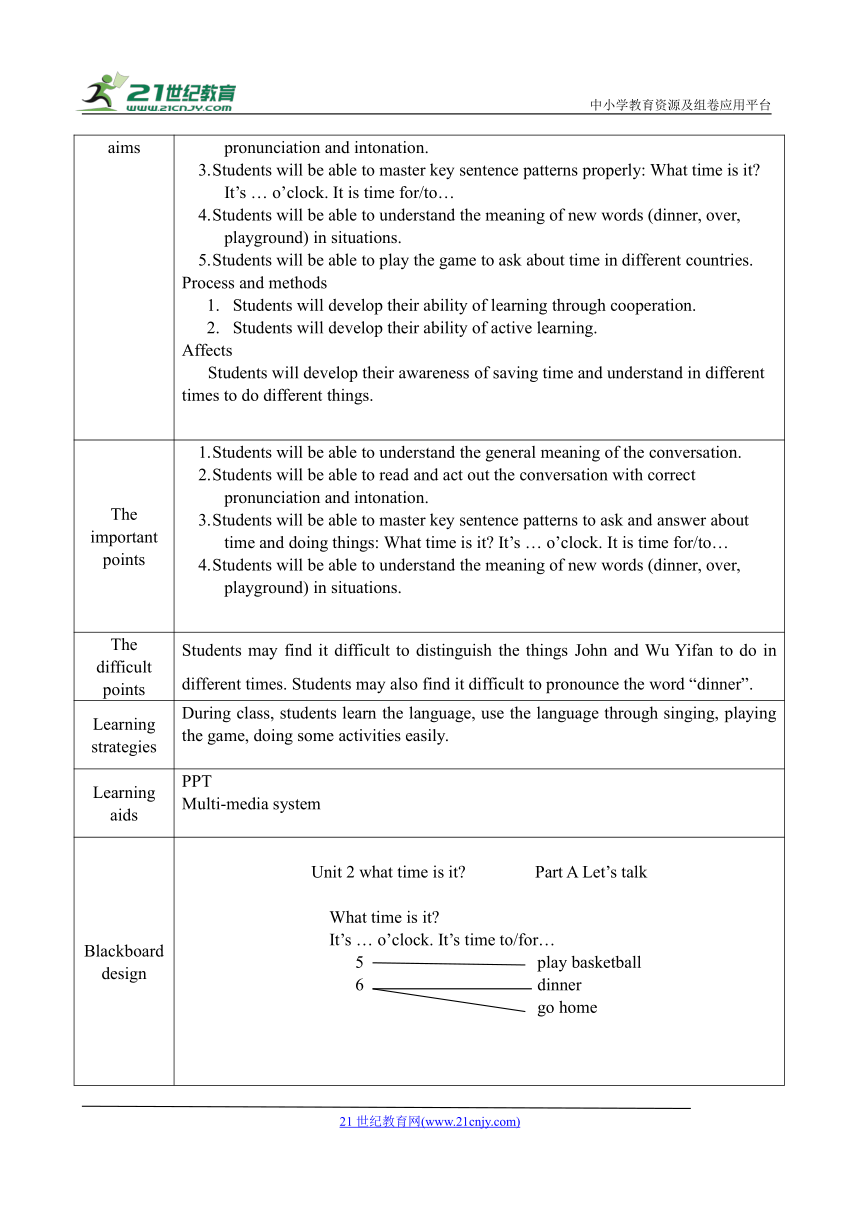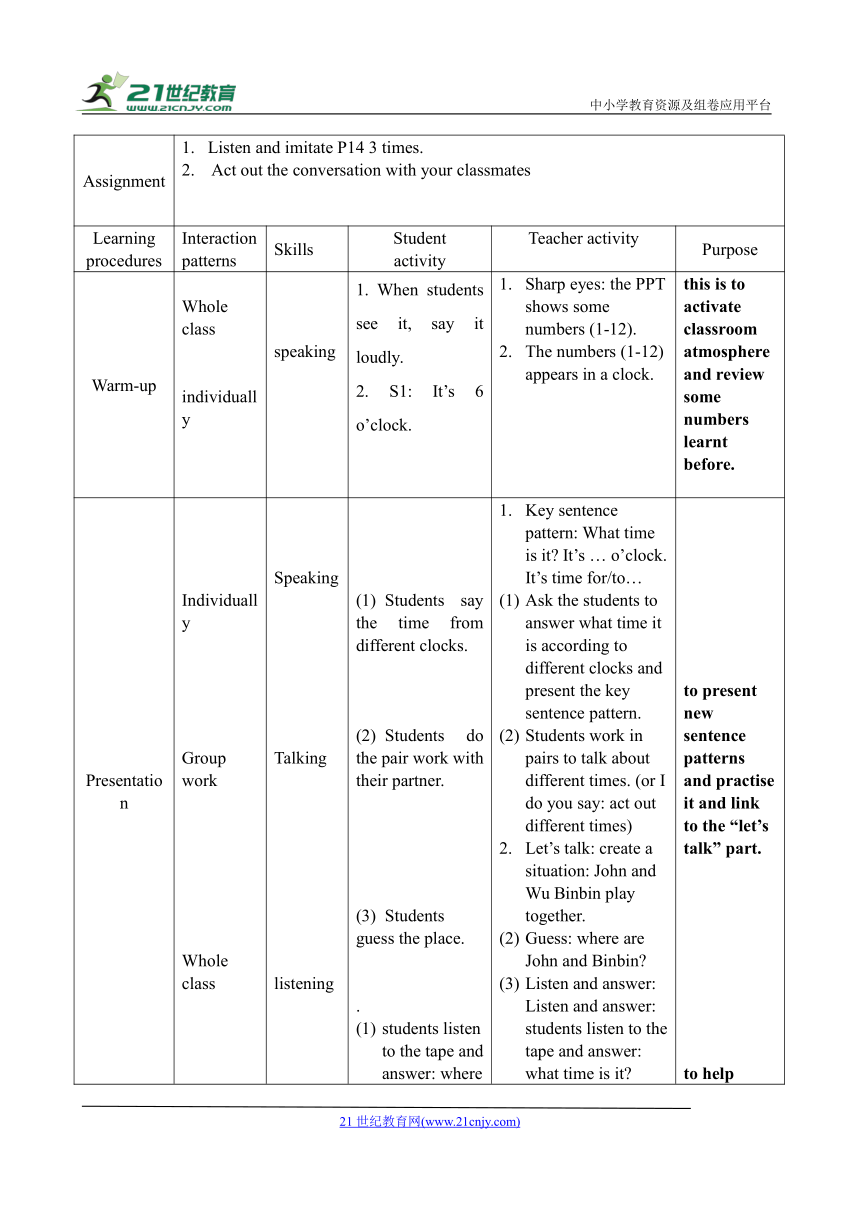Unit 2 What time is it 第1课时 A Let’s talk 表格式全英教学设计
文档属性
| 名称 | Unit 2 What time is it 第1课时 A Let’s talk 表格式全英教学设计 |  | |
| 格式 | doc | ||
| 文件大小 | 1.2MB | ||
| 资源类型 | 试卷 | ||
| 版本资源 | 人教版(PEP) | ||
| 科目 | 英语 | ||
| 更新时间 | 2022-05-25 15:08:30 | ||
图片预览



文档简介
中小学教育资源及组卷应用平台
Unit2 What time is it
(A Let’s talk)
Teacher Time & date Type of lesson Talk
Analysis of the unit The topic of this unit is to talk about the time. They key point of teaching is to guide students to learn the expression of the time and different activities by teaching vocabulary, sentence patterns and dialogues, starting from the actual life of students. Through the main scene map it shows the different times in different cities from a world map.Story time shows a funny story about April fool’s day.
Language materials
Materials analysis The material is taken from PEP 4B Unit2 with the title of “what time is it ” It’s the “Let’s talk” and “Let’s play” part of part A. This dialogue is (between Zhang Peng, John and school guard) about different times and activities. The key sentence patterns are “what time is it It’s … o’clock. It’s time for/to…” and the new words are: dinner, over, playground. There is a game (Let’s play) about different times in different countries.
The students’ language level Students may find it interesting to learn this material and find it easy to understand the conversation because the situation is closely related to their daily life. Moreover, they find it easy to learn new sentence patterns since they have learnt numbers (1-12) before. However, they may find it difficult to pronounce the word “dinner”.
The realistic learning aims Language skills and knowledge: Students will be able to understand the general meaning of the conversation. Students will be able to read and act out the conversation with correct pronunciation and intonation. Students will be able to master key sentence patterns properly: What time is it It’s … o’clock. It is time for/to… Students will be able to understand the meaning of new words (dinner, over, playground) in situations. Students will be able to play the game to ask about time in different countries. Process and methods Students will develop their ability of learning through cooperation. Students will develop their ability of active learning. Affects Students will develop their awareness of saving time and understand in different times to do different things.
The important points Students will be able to understand the general meaning of the conversation. Students will be able to read and act out the conversation with correct pronunciation and intonation. Students will be able to master key sentence patterns to ask and answer about time and doing things: What time is it It’s … o’clock. It is time for/to… Students will be able to understand the meaning of new words (dinner, over, playground) in situations.
The difficult points Students may find it difficult to distinguish the things John and Wu Yifan to do in different times. Students may also find it difficult to pronounce the word “dinner”.
Learning strategies During class, students learn the language, use the language through singing, playing the game, doing some activities easily.
Learning aids PPT Multi-media system
Blackboard design Unit 2 what time is it Part A Let’s talk What time is it It’s … o’clock. It’s time to/for… 5 play basketball 6 dinner go home
Assignment Listen and imitate P14 3 times. 2. Act out the conversation with your classmates
Learning procedures Interaction patterns Skills Student activity Teacher activity Purpose
Warm-up Whole class individually speaking 1. When students see it, say it loudly. 2. S1: It’s 6 o’clock. Sharp eyes: the PPT shows some numbers (1-12). The numbers (1-12) appears in a clock. this is to activate classroom atmosphere and review some numbers learnt before.
Presentation Individually Group work Whole class Speaking Talking listening Students say the time from different clocks. Students do the pair work with their partner. Students guess the place. . students listen to the tape and answer: where are John and Binbin Key sentence pattern: What time is it It’s … o’clock. It’s time for/to… Ask the students to answer what time it is according to different clocks and present the key sentence pattern. Students work in pairs to talk about different times. (or I do you say: act out different times) Let’s talk: create a situation: John and Wu Binbin play together. Guess: where are John and Binbin Listen and answer: Listen and answer: students listen to the tape and answer: what time is it Listen and match: It’s … o’clock. It’s time for/to…. 5 play basketball 6 dinner go home to present new sentence patterns and practise it and link to the “let’s talk” part. to help students understand the meaning of the conversation through many activities.
Practice Whole class Speaking Reading Imitation Watch the cartoon Read along Read after the tape Role play Dub the story Watch the cartoon Read along Read after the tape and pay attention to the pronunciation, intonation and emotion. Role play Dub the story to help students read and act out the conversation with correct pronunciation and intonation by different activities (e.g. role play).
Production Group work talking Students work in pairs and talk about what Amy does in different times in a day. 2.students work in groups of 4. Each student represents a city Create a new situation and talk: Amy’s day The PPT shows different times in a day and some pictures about what Amy does. Students work in pairs and talk about what Amy does in different times in a day. Let’s play: students work in groups of 4. Each student represents a city (Beijing, New York, London, Sydney). They use key sentence patterns (what time is it It’s … a.m./p.m. It’s time for/to…) to make a conversation. to ensure students can use new sentence patterns in situations correctly.
21世纪教育网(www.21cnjy.com)
Unit2 What time is it
(A Let’s talk)
Teacher Time & date Type of lesson Talk
Analysis of the unit The topic of this unit is to talk about the time. They key point of teaching is to guide students to learn the expression of the time and different activities by teaching vocabulary, sentence patterns and dialogues, starting from the actual life of students. Through the main scene map it shows the different times in different cities from a world map.Story time shows a funny story about April fool’s day.
Language materials
Materials analysis The material is taken from PEP 4B Unit2 with the title of “what time is it ” It’s the “Let’s talk” and “Let’s play” part of part A. This dialogue is (between Zhang Peng, John and school guard) about different times and activities. The key sentence patterns are “what time is it It’s … o’clock. It’s time for/to…” and the new words are: dinner, over, playground. There is a game (Let’s play) about different times in different countries.
The students’ language level Students may find it interesting to learn this material and find it easy to understand the conversation because the situation is closely related to their daily life. Moreover, they find it easy to learn new sentence patterns since they have learnt numbers (1-12) before. However, they may find it difficult to pronounce the word “dinner”.
The realistic learning aims Language skills and knowledge: Students will be able to understand the general meaning of the conversation. Students will be able to read and act out the conversation with correct pronunciation and intonation. Students will be able to master key sentence patterns properly: What time is it It’s … o’clock. It is time for/to… Students will be able to understand the meaning of new words (dinner, over, playground) in situations. Students will be able to play the game to ask about time in different countries. Process and methods Students will develop their ability of learning through cooperation. Students will develop their ability of active learning. Affects Students will develop their awareness of saving time and understand in different times to do different things.
The important points Students will be able to understand the general meaning of the conversation. Students will be able to read and act out the conversation with correct pronunciation and intonation. Students will be able to master key sentence patterns to ask and answer about time and doing things: What time is it It’s … o’clock. It is time for/to… Students will be able to understand the meaning of new words (dinner, over, playground) in situations.
The difficult points Students may find it difficult to distinguish the things John and Wu Yifan to do in different times. Students may also find it difficult to pronounce the word “dinner”.
Learning strategies During class, students learn the language, use the language through singing, playing the game, doing some activities easily.
Learning aids PPT Multi-media system
Blackboard design Unit 2 what time is it Part A Let’s talk What time is it It’s … o’clock. It’s time to/for… 5 play basketball 6 dinner go home
Assignment Listen and imitate P14 3 times. 2. Act out the conversation with your classmates
Learning procedures Interaction patterns Skills Student activity Teacher activity Purpose
Warm-up Whole class individually speaking 1. When students see it, say it loudly. 2. S1: It’s 6 o’clock. Sharp eyes: the PPT shows some numbers (1-12). The numbers (1-12) appears in a clock. this is to activate classroom atmosphere and review some numbers learnt before.
Presentation Individually Group work Whole class Speaking Talking listening Students say the time from different clocks. Students do the pair work with their partner. Students guess the place. . students listen to the tape and answer: where are John and Binbin Key sentence pattern: What time is it It’s … o’clock. It’s time for/to… Ask the students to answer what time it is according to different clocks and present the key sentence pattern. Students work in pairs to talk about different times. (or I do you say: act out different times) Let’s talk: create a situation: John and Wu Binbin play together. Guess: where are John and Binbin Listen and answer: Listen and answer: students listen to the tape and answer: what time is it Listen and match: It’s … o’clock. It’s time for/to…. 5 play basketball 6 dinner go home to present new sentence patterns and practise it and link to the “let’s talk” part. to help students understand the meaning of the conversation through many activities.
Practice Whole class Speaking Reading Imitation Watch the cartoon Read along Read after the tape Role play Dub the story Watch the cartoon Read along Read after the tape and pay attention to the pronunciation, intonation and emotion. Role play Dub the story to help students read and act out the conversation with correct pronunciation and intonation by different activities (e.g. role play).
Production Group work talking Students work in pairs and talk about what Amy does in different times in a day. 2.students work in groups of 4. Each student represents a city Create a new situation and talk: Amy’s day The PPT shows different times in a day and some pictures about what Amy does. Students work in pairs and talk about what Amy does in different times in a day. Let’s play: students work in groups of 4. Each student represents a city (Beijing, New York, London, Sydney). They use key sentence patterns (what time is it It’s … a.m./p.m. It’s time for/to…) to make a conversation. to ensure students can use new sentence patterns in situations correctly.
21世纪教育网(www.21cnjy.com)
